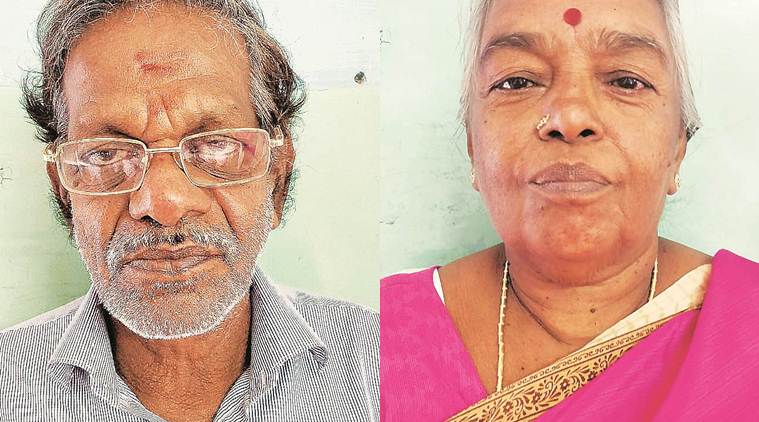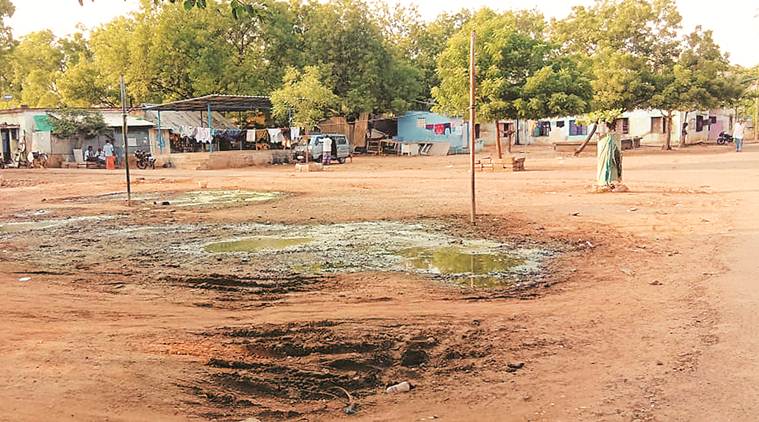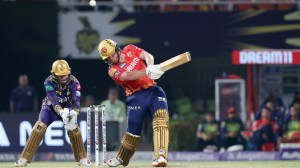- India
- International
‘They did not see us’
Left out by citizenship Act, Lankan Tamil refugees hold on to personal, parents’ papers at a camp in Tamil Nadu.
 Saroja Devi fled Nuwara Eliya in Central Sri Lanka during the anti-Tamil riots in 1983, and still lives in the Kottapattu refugee camp on the suburbs of Trichy with her husband
Saroja Devi fled Nuwara Eliya in Central Sri Lanka during the anti-Tamil riots in 1983, and still lives in the Kottapattu refugee camp on the suburbs of Trichy with her husband
TILL THE last moment”, they hoped — that the Citizenship Amendment Act would include them too, that their three-decade wait would end, that their life in a camp would be finally over. But the Act passed by Parliament on December 11 covered refugees from only Pakistan, Afghanistan and Bangladesh.
“They did not see us… We were shattered,” says Saroja Devi, 61, who fled Nuwara Eliya in Central Sri Lanka during the anti-Tamil riots in 1983, and still lives in the Kottapattu refugee camp on the suburbs of Trichy in Tamil Nadu, like 400-odd Sri Lankan families.
Married for just four years, Saroja Devi escaped with her husband in July 1983 after a Sinhalese mob torched their home, forcing them first into a hideout on a hilltop and then to take a one-way flight to Thirvananthapuram on an ‘emergency passport’. From Thiruvananthapuram, they rode 500 km on a bus to Trichy. “The same day, we were allotted a single-room house. We continue to live in that house in the hope of an Indian citizenship.”
Explained: What is the Citizenship Amendment Bill?
Saroja’s husband S Rangasamy, once a tea estate supervisor near Kandy in Lanka, is now 71, their son now 39.
What fuelled their hopes was that their Lankan birth certificates recognise the couple as ‘Indian Origin’ — as their grandparents had moved from India to Lanka a century ago to work in the tea plantations. But Lanka never recognised them and, post-CAA, they have fresh fears about their status.
In her one-room house, Saroja preserves carefully the land records and pictures of the ancestral property in Sholingapuram in Vellore that her grandparents left behind. Rangasamy’s grandparents were also from Tamil Nadu, specifically Thanjavur. “We took courage from the fact that an ‘Indian Tamil’ tag meant we were going back to our own country,” she says.

Among the 400 Lankan refugee families at the Kottapattu camp, over 100 have Indian links. Tamil Nadu has 107 camps for Lankan Tamil refugees, housing about 19,000 families or 60,000 inmates, of whom at least 20 per cent are Indian-origin. Almost all the refugees arrived between the early 1980s and 1990s. About 10,000 are children below the age of eight.
 The Kottapattu camp near Trichy. Among the 400 Lankan refugee families here, over 100 have Indian links, like Rajeshwari, S Rangasamy (below). Arun Janardhanan
The Kottapattu camp near Trichy. Among the 400 Lankan refugee families here, over 100 have Indian links, like Rajeshwari, S Rangasamy (below). Arun Janardhanan
Of the 4.6 lakh believed to have left Lanka since 1983 driven by ethnic violence, many made their way to Europe. Some managed citizenship, some got married to Indians, and at least 30,000 continue to live outside camps and must report periodically to the nearest police station.
Explained | How the citizenship amendment law differs from Bill that LS cleared in January
Camp inmates are not allowed to visit other states, and prior permission is required even if they go out of the district. Apart from free living space, they get 57 paise per kilo rice from the age of eight, up to 12 kg per month. Besides this, a family head gets an allowance of Rs 1,000 per month, spouses Rs 750, and children below the age of 12, Rs 400.
While the Madras High Court had granted Saroja and Rangasamy the go-ahead to file for citizenship in June last year, along with 33 others, they are not very hopeful.
Says M Subramaniam, also an ‘Indian origin’ refugee, “With the court order, we went to the Collector. He asked us to apply online. As the online system had no such options, we returned to the Collector again. He directed us to the Tamil Nadu Q-branch police, where we submitted petitions seeking citizenship. I haven’t heard anything from them in the past four months.”
Opinion | A misinformation campaign is underway to make Muslims fearful of CAA
Back in Lanka, Subramaniam owned a house and a textile shop near Colombo, and lived a comfortable life with his wife and three children. Among the eldest at the camp, well-regarded by the others, the 76-year-old breaks down, saying, “Life has been so cruel. No one could have gone through this much suffering.”
Another inmate, Rajeshwari, who fled Kandy with husband and son at the peak of the ethnic clashes in 1985, says her ancestors were from Pudukottai. “After reaching here, we went to our native village. But we decided to move to the camp as our relatives are poor and couldn’t support us.”
She claims that because she was wearing jewellery, the officials at first refused to allow her into the Kottapattu camp. “Finally my husband managed to get to Chennai in a lorry at night and visited the passport office, where a good officer sent him to meet then chief minister M G Ramachandran. MGR was unwell by then, unable to speak, but he hugged him, and directed officials in the Trichy camp to admit us.”
A woman refugee at the Trichy camp, who also requested anonymity, says officials are often clueless about different categories of refugees. “They do not understand the difference between Indian-origin inmates and Lankan-origin Tamils, they tag all of us together,” says the refugee, who is in her 40s, and whose father was of Indian origin and mother a Lankan from Jaffna. They died a decade ago and since then, she lives alone. “People used to have sympathy for us. Things changed after the Rajiv Gandhi assassination,” she says.
Also Read | How Jamia has ended up as the focal point of the current unrest
While all parties in Tamil Nadu have tried to gain mileage by speaking for the Lankan cause, most refugees in Trichy say politicians have been of no use. “The DMK did nothing for us even when they had so much power in Delhi (during UPA time), though Kalaignar (the late M Karunanidhi) gave us TVs. Vaiko (MDMK leader) and Seeman (leader of Naam Tamilar Katchi) heard us, but only that. We were taken to meet BJP leaders, but they didn’t even consider us when passing this Act. The late J Jayalalithaa though always thought of us in her policies,” says a Lankan at the camp.
S C Chandrahasan’s Organisation for Eelam Refugees Rehabilitation is perhaps the only recognised NGO allowed to work for the refugees at these camps. The son of S J V Chelvanayakam, a prominent Sri Lankan Tamil leader, Chandrahasan says that technically all those who are in camps in India are supposed to return. However, they are afraid.
Adding that India doesn’t see them as Sri Lankan refugees but as ‘people in distress’, Chandrahasan adds, “There is no such process in India to give citizenship, these camps were an arrangement to accommodate people in distress, to make them feel safe, before they went back to Sri Lanka once normalcy was restored. The European style of giving asylum and citizenship to refugees is individual-based. That is impossible in India as there are thousands of Tamil refugees.”
Apr 26: Latest News
- 01
- 02
- 03
- 04
- 05







































